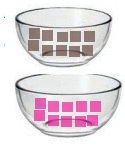Number System | Term 1 Chapter 1 | 7th Maths - Addition of Integers | 7th Maths : Term 1 Unit 1 : Number System
Chapter: 7th Maths : Term 1 Unit 1 : Number System
Addition of Integers
Addition
of Integers
The number line is a simple tool to visualise
addition of integers. Let us do an activity with the number line.
Imagine that the number line is a road with
markers on it. We are allowed to step forward or backward on this road. One
step taken is equal to one unit of number. Initially we start at zero and face
positive direction. We step forward for positive integers and backward for
negative integers. We maintain the same positive direction for addition
operation.

To add (+5) and (–3), We start at zero facing
positive direction and move five steps forward to represent (+5). Since the
operation is addition we maintain the same direction and move three units
backward to represent (–3). We land at +2. So, (+5)+(–3)=2. This is shown in
Fig.1.5.

Proceeding in the same way let us try another
example. Find the sum of (–6) and (–4). We start at zero facing positive
direction continuing in the same direction and move 6 units backward to
represent (–6) and in the same direction move 4 units backward to represent
(–4). We land at (–10).
Therefore, (–6)+(–4) = –10

Try this
Find the value of the following using the number line activity:
(i) (–4) + (+3)

–4 + 3
= –1
(ii) (–4) + (–3)

(–4) +(–3) = –7
(iii)
(+4) + (–3)

(+4) + (–3) = +l
Activity
There are two bowls with tokens
of two different colours brown and pink. Let us denote one brown token by (+1)
and one pink token by (–1). A pair of tokens, brown (+1) and pink (–1), will
denote zero [1+(–1)=0]

To add two integers, we pick the
required number of tokens and form possible zero pairs. The remaining number of
tokens left after pairing is the sum of the two integers.

To add (–7) and (+5) we pick 7
pink tokens and 5 brown tokens. We form zero pairs from the tokens as above. We
can form 5 zero pairs. Then we are left with 2 pink tokens. Hence, ( −7) + (+5) = −2 .

To add (–3) and (–4) we pick 3
pink tokens first and 4 pink tokens later. The total number of tokens is 7 pink
tokens. There are no zero pairs. So, the sum of (–3) and (–4) is (–7). Teacher
can give different integers and ask them to add using tokens.
Note
1. When
we add two integers of the same sign the sum will also be an integer of the
same sign. When we add two integers of different sign, the sum will be the
difference between the two integers and have the sign of the integer with
greater value.
1. The integer wihtout sign
represents positive interger.
Example 1.1
Add the following integers using number line
(i) 10 and –15 (ii) –7 and –9
Solution
Let us add the intergers using number line
(i) 10 and –15

On the number line we first start at zero
facing positive direction and move 10 steps forward, reaching 10. Then we move
15 steps backward to represent –15 and reach at –5. Thus, we get 10 + (–15) =
–5.
(ii) –7 and –9

On the number line we first start at zero
facing positive direction and move 7 steps backward, reaching –7. Then we move
9 steps backward to represent –9 and reach at –16. Thus, we get (–7) + (–9) =
–16.
Example 1.2
Add (i) (–40) and (30) (ii) 60 and (–50)
Solution
(i) (–40) and (30)
–40 + 30 = –10
(ii) 60
and (–50)
60+(–50)=60–50=10
Example 1.3
Add: (i) (–70) and (–12) (ii) 103 and 39.
Solution
(i) (–70) + (–12) = –70 – 12 = – 82
(ii) 103 + 39 = 142
Example 1.4
A submarine is at 32 feet below the sea level.
Then it moves up 8 feet. Find the depth of the submarine.
Solution
A
submarine is 32 feet below sea level.
Therefore, it is represented by –32
Next it moves up 8 feet.
Moves above is represented as +8
The depth of the submarine = –32 + 8 = –24
Therefore, the submarine is located at 24 feet
below the sea level.
Example 1.5
Sita saved ₹ 225.00 and she has spent ₹ 400 on
credit basis for the purchase of stationery.
Find her due amount.
Solution
The amount Sita has ₹ 225
The amount spent for stationery on credit =₹400
The due
amount to be paid = ₹225 – ₹400 = –₹175
Therefore, Sita has to pay ₹ 175
Example 1.6
From the ground floor a man went up six floors
and came down six floors. In which floor is he now?
Solution
Starting point = Ground floor
Number
of floors climbed up = +6
Number
of floors climbed down = –6
Now the
landing point = +6 – 6 = 0 (ground floor)
Related Topics